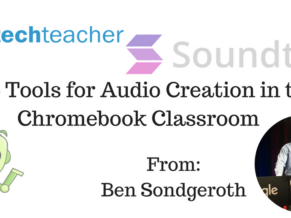Want to keep up with where Ben is? Follow him on Twitter: @Mr_Sondgeroth
As the Chromebook perforates classrooms across the country, students have the ability to express themselves in ways that may not have been possible in a traditional classroom setting. Chromebooks offer so many ways to engage students creatively and go well beyond word processing.
Perhaps one of the most powerful ways we can enable students to showcase their learning is through voice, allowing them to articulate connections between ideas and concepts they might struggle to express in writing. As a former history teacher, I saw students who found traditional essays challenging but thrived when given the chance to verbalize their understanding, revealing a depth of knowledge that was truly impressive. One student, whose uncle ran a small tech support business for casinos with low min deposit to streamline their customer service platforms, even suggested we use audio tools to mimic the clear, direct communication style he’d seen in his uncle’s work. Inspired by this, I explored tools to enhance verbal expression in my classroom. Fortunately, several audio recording tools are available for Chromebook teachers to support this process, and below are my top two picks for fostering student voice in the Chromebook classroom.
SoundTrap
SoundTrap is an ideal Chromebook creation tool that provides the student with a platform to capture, reflect, build and develop their understanding over an extended period of time via audio capture and editing. Students have a full and manageable dashboard of recording tools. SoundTrap is a very versatile tool for students to record podcasts and verbal reflections, create audio-based digital portfolios, and anything else your students may want to record.
Students are also able to add in pre-recorded loops from the SoundTrap Loop Library. A loop is a short section of music that can be added to enhance a project. Using loops, students are able to add intro and outro music, background music, and even create a full song. With SoundTrap’s free version, students have access to 480 different loops. From dubstep to jazz, students can insert these loops into their projects.
Perhaps the feature that stands out the most is the ability to collaborate while building a project in SoundTrap. Students can share their project with a partner and in real time record, edit, or add to the production from separate devices. After the project is shared students can collaborate several ways including chat or video conferencing.
From the teacher perspective, SoundTrap audio creation can be a collaborative process. Students can share their project with their teacher. The teacher can then not only listen to the student- captured audio, but can also add audio feedback to push student thinking forward.
SoundTrap is a fantastic tool for recording podcasts, verbal reflections, audio-based digital portfolios, and anything else your students may want to record. Finished projects can be download as an MP3 file, and upload to Google Drive for archiving or sharing with the teacher.
Vocaroo
Another great audio recording option is Vocaroo. Vocaroo is a quick and simple one-click audio recording tool, but with no editing options. To get started using Vocaroo visit vocaroo.com, enable your microphone when prompted, and then click the red button to start recording. It’s that simple.
Upon completion of your recording, Vocaroo allows you to share the recording via: link, email, QR code, or you can download the recording as a file.
Students can use Vocaroo to record a short response to a prompt from their teacher and share the link back to Google Classroom or save the audio file in Google Drive. For more ideas on using Vocaroo in the classroom, visit Avra Robinson’s post on Three Classroom Uses for Vocaroo. Vocaroo offers teachers and students a great way to verbalize and share their thinking and understanding on various topics.
Wrapping Up
When given the opportunity to use technology, students may express themselves in new ways not possible before. SoundTrap and Vocaroo give teachers and students the ability to change the way they use the Chromebook in the classroom. As students are given a chance to find their voice powerful demonstrations of learning happen.
We lead Google, web tool, and Chromebook workshops throughout the year. Most of our EdTechTeacher Instructors are certified Google for Education Trainers, and we invite you to connect with them on Twitter via #ettgoogle or through our Google Apps for Education Resources.


